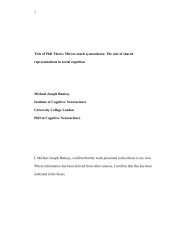An investigation of the relationship between BOLD and perfusion ...
An investigation of the relationship between BOLD and perfusion ...
An investigation of the relationship between BOLD and perfusion ...
Create successful ePaper yourself
Turn your PDF publications into a flip-book with our unique Google optimized e-Paper software.
following label images was used to remove effects <strong>of</strong> <strong>BOLD</strong> signal fluctuation within<br />
one TR (Aguirre et al., 2002), <strong>and</strong> expressed as a ratio <strong>of</strong> <strong>the</strong> control image to<br />
remove <strong>BOLD</strong> contrast present in both label <strong>and</strong> control images (Garraux et al.,<br />
2005) <strong>and</strong> create a relative CBF time series.<br />
We thresholded difference images according to Garraux et al (Garraux et al.,<br />
2005). In brief, abnormal flow values that did not fall within a physiological range<br />
(e.g. due to head motion) were removed, by retaining only 1) pairs <strong>of</strong> voxels where<br />
control signal intensity had a value greater than 80% <strong>of</strong> <strong>the</strong> global mean intensity <strong>of</strong><br />
<strong>the</strong> control image, <strong>and</strong> 2) voxels with a fractional signal change <strong>of</strong> less than ± 5%.<br />
A corresponding <strong>BOLD</strong> sensitive time series was calculated from <strong>the</strong> ASL data by<br />
summation <strong>of</strong> adjacent label <strong>and</strong> control images.<br />
<strong>BOLD</strong> <strong>and</strong> CBF correlation analysis<br />
Firstly, a design matrix was created using SPM for both <strong>the</strong> ASL <strong>and</strong> <strong>BOLD</strong> time<br />
series <strong>and</strong> used to generate a time series <strong>of</strong> <strong>the</strong> confounding variance (due to<br />
motion) that was <strong>the</strong>n removed by subtraction. Then linear drift was removed from<br />
<strong>the</strong> <strong>BOLD</strong> time course (using <strong>the</strong> Matlab detrend.m function). Both <strong>the</strong>se time series<br />
were converted into units <strong>of</strong> %change which will be referred to as ∆<strong>BOLD</strong> <strong>and</strong> ∆CBF<br />
measurements. Pixels with a very low (e.g. white matter) or very high (e.g. edges)<br />
mean ∆CBF were removed.<br />
To investigate <strong>the</strong> coupling <strong>between</strong> <strong>the</strong> ∆CBF <strong>and</strong> ∆<strong>BOLD</strong> measurements, we<br />
performed a voxel-wise linear regression <strong>between</strong> <strong>the</strong> two using a one way analysis<br />
<strong>of</strong> covariance (ANCOVA) as implemented in <strong>the</strong> aoctool.m function in <strong>the</strong> Matlab<br />
statistics toolbox (www.mathworks.com). <strong>An</strong> additional regressor used to assign <strong>the</strong><br />
data at each time point to ei<strong>the</strong>r 1) a rest epoch (images acquired during background<br />
EEG activity), or 2) a GSW epoch (images acquired during GSW). This is used to<br />
determine if <strong>the</strong>re is a difference in this <strong>relationship</strong> <strong>between</strong> EEG-defined states<br />
(rest <strong>and</strong> GSW). In particular, we examined <strong>the</strong> slope <strong>of</strong> <strong>the</strong> ∆CBF <strong>and</strong> ∆<strong>BOLD</strong> on a<br />
voxelwise basis (p

















